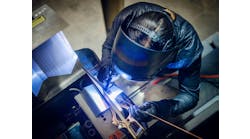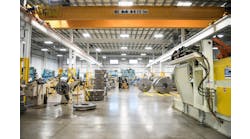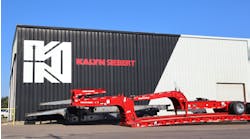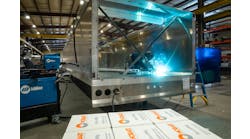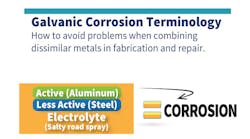TRAILER manufacturers know that when using two dissimilar metals, precautions need to be taken to prevent two-metal (galvanic) corrosion. That applies even to the “all-aluminum” design, which uses steel frames in the axle and coupler areas.
So how does a manufacturer approach the problem?
Jimmy Yglesias, who was active in the Technology and Maintenance Council's S.7 group and chaired the task force investigating dissimilar metals and ways to prevent corrosion, believed that in order to avoid or minimize the effect of corrosion, it is important to understand why it occurs.
“When two different metals are in contact and subject to a corrosive or conductive environment, there is a current flow between them,” he wrote in TMC's Recommended Practice 740, “Corrosion Protection From Dissimilar Metals.”
“This current flow causes the corrosion of the least corrosion-resistant (active) metal to increase and corrosion of the more corrosion-resistant (inactive) metal to decrease. Because current flow and dissimilar metals are involved, this form of corrosion is called galvanic, or two-metal corrosion. Corrosion progressively destroys the metal, causing weakness, which can lead to failure.
“This mechanism is what allows a dry-cell battery to produce electricity. The plus terminal of the battery is a corrosion-resistant metal while the minus terminal is the least corrosion-resistant and therefore corrodes. This promotes current flow through the conductive gel in the battery. When the least corrosion-resistant metal is corroded away, the battery has to be replaced.”
Yglesias wrote that metals used in trailer or body construction can be ranked as “active” or “inactive.”
“The corrosion rate is related to the distance between the metals in the ranking; the further apart the metals, the worse the corrosion rate,” he wrote. “For example, aluminum is listed toward the active end, while stainless steel is listed toward the inactive end. If aluminum and stainless steel were immersed in a corrosive environment (road salt solution) the corrosive rate of the aluminum would be highly accelerated while the rate of the stainless steel would be reduced.
“Note that aluminum is close in activity with steel. However, they are still dissimilar metals and are subject to considerable galvanic corrosion when in contact in a corrosive atmosphere. Awareness of this ranking and the effect it has on corrosion rates is critical to the initial construction and repair of trailers and bodies. When dissimilar metals come in contact, which is unavoidable, there are several design guidelines that can be employed to minimize galvanic corrosion.”
He wrote that dissimilar metals do not have to be submerged in a conductive medium for galvanic corrosion to occur, that it also occurs in the atmosphere and is dependent on the amount of moisture, the amount of oxygen, the conductivity, and the temperature.
“Galvanic corrosion does not occur when dissimilar metals are completely dry,” he wrote. “The likelihood of trailer and body components remaining completely dry is questionable. Therefore, care must be also taken to keep moisture to a minimum throughout the entire production of the trailer.
“The corrosion rate of the dissimilar metals not only depends on the environment and the difference in potential, but also the respective amount of the dissimilar metals. For example, an unfavorable situation would be to have a large area of inactive metal and a small area of active metal in any particular joint design. If this condition exists, the smaller active metal could corrode at an accelerated rate. This fact is particularly important to remember when using fasteners, bolts, and rivets, since they have a relatively small area in respect to the pieces of metal that are being connected.”
He listed these four points to consider when joining dissimilar metals with fasteners, rivets, screws, or bolts:
- Pay careful attention to the corrosion potential chart and remember not to place a small amount of active metal in contact with a large amount of inactive metal. For example, never place an aluminum rivet in a large piece of steel.
- When connecting two pieces of the same material, use a fastener/bolt made of the same material. For example, use an aluminum fastener when connecting two pieces of aluminum.
- If the subjects being fastened are structural, use a fastener/bolt of appropriate strength. For example, when fastening aluminum and steel in a structural application, use a fastener made of carbon steel with suitable plating.
- Use the corrosion potential chart when selecting fastener/bolt material. Remember to never use materials far apart (i.e., never use a fastener made of brass or copper to fasten aluminum and steel.)
Finally, here are Yglesias' preventive measures to use when unavoidable conditions exist:
- If using the same metal is not possible, select combinations of metals close together.
- Avoid small active metal contact with large inactive metal content.
- When dissimilar metals come in contact, use a nonabsorbent insulate between them. A polypropylene tape of 1.7 mils minimum thickness with a dielectric strength of 300-400 volts/mil is adequate for most trailer and body applications.
- Paint or prime the two metals or selected pieces, even if they have protective coatings. This is especially helpful in joints, if kept in good repair. It is particularly important to coat the active metal.
- Avoid threaded fittings with materials far apart in the ranking. Use washers, gaskets, and sleeves made of plastic or a compatible metal before connecting dissimilar metals.
- Design for the use of replaceable active metal components or make them thicker for longer life.
- Where possible, use tape instead of caulk. Caulk in a joint between dissimilar metals can squeeze out and allow the two metals to contact. Closed-cell neoprene tape tends to do a better job of isolating.
- Consider using sacrificial anodes. The installation of yet a more active metal than the active metal in a joint will tend to corrode the most active metal and protect the less active metal. This is known as a sacrificial anode but seldom done on trailers and bodies.
- Use one-piece or welded construction versus bolting or riveting when possible.
- If the above measures are not applicable for a joint design, care must be taken to ensure that moisture is allowed to drain.
- Apply corrosion-inhibiting material (pastes, washers, compounds, etc.) under heads of screws or bolts inserted into dissimilar metal, even if they already have been treated.
“We (Great Dane Trailers) necessarily have to use a lot of dissimilar metals — all manufacturers do,” says Charlie Fetz, Great Dane's vice president of research and development. “It's certainly not a new problem. We try to use prudent design practices. In a lot of trailers, you have to isolate them with electrical insulating tape and/or coatings. If you have not used good design and manufacturing practices, the sacrificial metal of the two metals will suffer. I think the suggestions Jimmy makes sound very prudent to me.”
Related websites
- What's corrosion?
www.anchorguard.com/reference_understand_what.cfm - Anodic index
www.engineersedge.com/galvanic_capatability.htm - Galvanic table
- www.eaa1000.av.org/technicl/corrosion/galvanic.htm
- Galvanic series and information
www.corrosion-doctors.org/Forms-galvanic/galvanic-corrosion.htm - The corrosion process
www.gordonengland.co.uk/corrosion.htm

